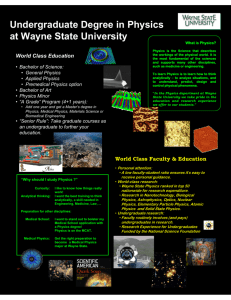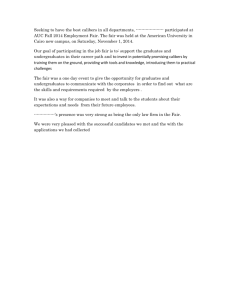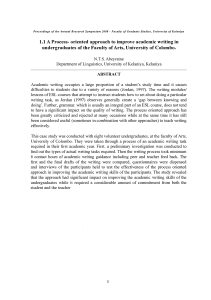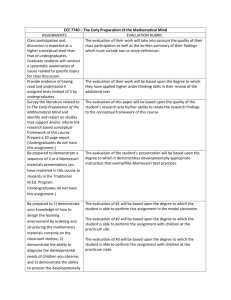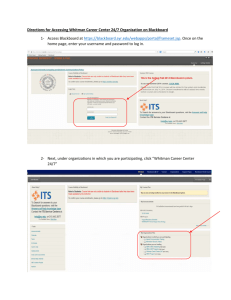Engaging Undergraduates in Science Research
advertisement
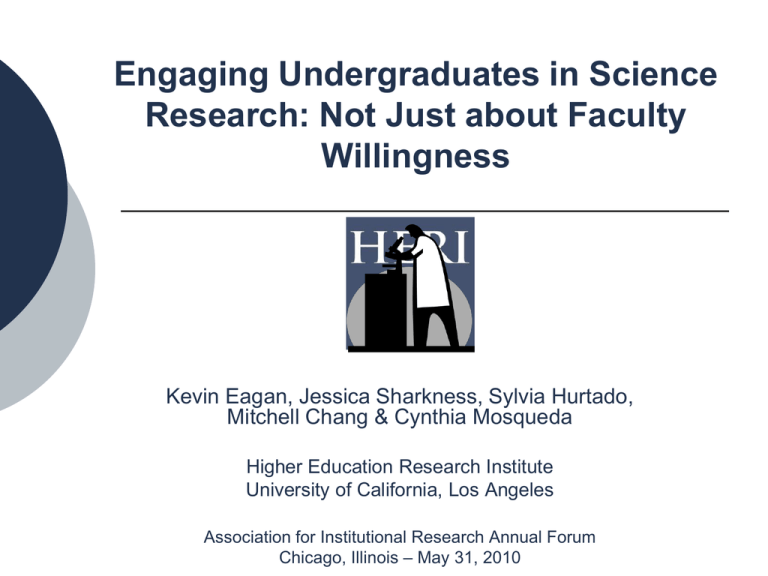
Engaging Undergraduates in Science Research: Not Just about Faculty Willingness Kevin Eagan, Jessica Sharkness, Sylvia Hurtado, Mitchell Chang & Cynthia Mosqueda Higher Education Research Institute University of California, Los Angeles Association for Institutional Research Annual Forum Chicago, Illinois – May 31, 2010 Background College freshmen who aspire to degrees in science, technology, engineering or mathematics (STEM) have lower completion rates than their non-STEM major peers Rates are even lower for underrepresented minorities 50% 40% 4-year STEM degree completion, by race (HERI, 2010) 32.4% 30% 24.5% 20% 15.9% 14.0% 13.2% Latino/a Native American Black/ African American 10% 0% Asian/ Pacific Islander White Undergraduate Research Experience Provides students with hands-on training Several benefits: Improved ability to work and think like a scientist Improved preparedness or desire for graduate study Higher STEM retention rates Develop close ties with faculty members Few studies explore factors influencing faculty members’ decisions to involve undergraduates in their research Faculty Workload Workload increase in last 25 years Time allocations vary Rewards greatest for research-oriented faculty By institutional type, rank, tenure status, discipline, gender, race/ethnicity and marital status Pay, tenure, Status Implementing and maintaining research programs is resource-intensive Requires time, support staff and institutional/ departmental support Faculty Mentorship Mutual benefits for protégé and mentor Few incentives for faculty to become mentors Disincentives: research and publishing is rewarded, mentorship can be time consuming Large classes, high student-faculty ratios can make it difficult to establish meaningful faculty/student relationships Students tend to rely on faculty to establish mentoring relationships Conceptual Framework Organizational Citizenship: Exerting more effort on the job than is required or expected by formal role prescriptions (McManus & Russell, 1997) Taking on undergraduate students doing research is often “above and beyond” the call of duty for faculty Two primary components: Actions and decisions targeted for certain individuals Activities directed at an organization (Organ & Ryan, 1995) Research Questions What predicts STEM faculty members’ likelihood of involving undergraduate students in their research projects? What factors account for the variation across institutions in STEM faculty members’ average likelihood of involving undergraduate students in their research projects? Data and Sample Data Source and Sample: 2007-2008 HERI Faculty Survey 4,765 STEM faculty members from 193 institutions Dependent Variable: During the past two years, have you engaged undergraduates on your research project (Yes = 1, No = 0) Engaged undergrads in research? No, 39% Yes, 61% Analyses Hierarchical Generalized Linear Modeling (HGLM) Appropriate for multi-level data with dichotomous outcome Level 1 Predictors Level 2 Predictors Demographic Characteristics Institutional Characteristics Professional Career (Tenure, rank, etc.) Institutional Selectivity Teaching and Scholarly activities Aggregated Faculty Variables Publications and funding Goals for undergraduates Perceptions of Institutional Climate Significant predictors reported as delta-p (Δ-p) statistics Results: Level 1 Level-1 Predictors* Delta-P Professional Career Time since appointed at present institution -0.48% Discipline (Biological/Life sciences is reference) Engineering and Computer Sciences -17.04% Health Sciences -34.55% Physical Sciences -19.97% Teaching Activities Taught an honors course 9.63% Taught an interdisciplinary course 5.76% Number of graduate courses taught -3.69% *We only show significant predictors. Results: Level 1 (cont’d) Other Scholarly Activities Level-1 Predictors Delta-P Scholarly Activities (other than teaching) Collaborated with the local community in research/teaching 7.94% Advised student groups involved in service/volunteer work 7.08% HPW engaged in research/scholarly writing 4.87% Extent: engage in academic work spanning multiple disciplines 5.51% Extent: mentor new faculty 5.09% Publications and Funding Number of articles published in academic/prof. journals (career) 4.41% Number of published books, manuals or monographs (career) -3.87% Source of stress: Research or publishing demands 8.58% Received funding for work from foundations 8.58% Received funding for work from state or federal government 13.22% Received funding for work from business or industry 7.73% Results: Level 1 (cont’d) Undergraduate Goals and Institutional Climate Level-1 Predictors Delta-P Goals for Undergraduates Encourage student habits of mind for learning (factor) 6.64% Institutional Climate Agree: faculty feel most students well-prepared academically 3.50% Agree: faculty strongly interested in acad. problems of ugrads 3.65% Agree: my research is valued by faculty in my department 3.04% Results: Level 2 Level-2 Predictors Delta-P HBCU 17.03% Liberal Arts Institution (Carnegie) 13.03% Institutional Selectivity (in 100-point increments) 3.50% Model Statistics Explained variance at Level 2 0.59 Baseline probability of inclusion of undergrads in research 0.61 Discussion Institutional context Faculty perceptions of institutional climate Disciplinary context Face-time with undergraduates, goals for undergraduates Funding Conclusion & Future Directions Future research Type and quality of UG research opportunities Fuller accounting of faculty effort in involving undergraduates in research Conclusions Incentivizing behavior Institutionalizing undergraduate research Contact Information Faculty and Co-PIs: Sylvia Hurtado Mitchell Chang Postdoctoral Scholars: Kevin Eagan Josephine Gasiewski Administrative Staff: Aaron Pearl Graduate Research Assistants: Monica Lin Cindy Mosqueda Christopher Newman Gina Garcia Juan Garibay Minh Tran Felisha Herrera Jessica Sharkness Papers and reports are available for download from project website: www.heri.ucla.edu/nih Project e-mail: herinih@ucla.edu Acknowledgments: This study was made possible by the support of the National Institute of General Medical Sciences, NIH Grant Numbers 1 R01 GMO71968-01 and R01 GMO71968-05 as well as the National Science Foundation, NSF Grant Number 0757076. This independent research and the views expressed here do not indicate endorsement by the sponsors. HERI Faculty Survey 2010-2011 Registration is now open Go to www.heri.ucla.edu for more information about participating
